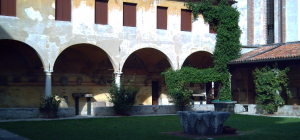Bassano del Grappa is a medium-sized town located in the Veneto region of northern Italy, in the province of Vicenza. The town is situated at the point where the flat Veneto plains reach the hills leading up to the Alps; it takes its name from the nearby Monte Grappa. The four things for which Bassano del Grappa is best known are its covered bridge over the Brenta, the strong grappa liqueur produced in the area, the military history of Monte Grappa and locally-produced ceramics. The architecture reflects Bassano’s location: typical Veneto-style arcaded streets and piazzas are interspersed with alpine wooden balconies, and some of the hostelries have a decidedly Austrian flavour.
The historic centre of Bassano is pretty and very compact: there are several sights to see and the town makes a good day-trip destination.
The town centre is full of attractive streets and three attractive linked piazzas ornamented with cafes, shops, churches and chatting locals. There are several pretty view-points.
What to see:
THE OLD BRIDGE
The most famous view of Bassano del Grappa is of its principal landmark, the Ponte degli Alpini, also known as the Ponte Vecchio (‘Old Bridge’). This covered wooden bridge over the Brenta river was designed by Andrea Palladio in 1569 to replace earlier incarnations. The bridge has been rebuilt more than once to the same design, and its current name dates back to the rebuilding after destruction in the Second World War, which was carried out by the Alpini, Italy’s Alpine Troops. At the western end of the bridge there is a little museum dedicated to them: the Museo degli Alpini (entered through the tavern above). This contains photographs and relicts of various military campaigns, but principally the First World War fighting on Monte Grappa. The museum also contains photos and items recording the local horror of 1944 when the occupying Germans hung 31 Italian partisans from trees. The panoramic Viale dei Martiri is now named for these men, and they are recorded by little shrines along its length.
THE CIVIC MUSEUM
The Museo Civico, the town museum, is situated in the former convent alongside the church of San Francesco in Piazza Garibaldi. It has a small archaeological section with finds from local excavations, and also a fine collection of Apulian vases donated by a local collector. The museum’s main attraction can be found upstairs, though, where a spacious art gallery houses many works by the local dal Ponte or Bassano family, including a hall dedicated to the most renowned: Jacopo Bassano. There are also works by other artists, many local, including views of Venice and other parts of Italy, portraits. A larger exhibition space is devoted to the sculptor Antonio Canova, and contains many of his plaster models for statues.
BASSANO’S GRAPPA
Bassano’s famous alcoholic product, grappa, takes its name, like the town, from the mountain. The fiery liqueur, which comes in many varieties, is made from leftovers of the winemaking process. It can be found all over Italy, but this area is particularly renowned for its grappa.
GIARDINI PAROLINI
Bassano is proud of its botanic gardens, the Giardini Parolini, which were created in the early nineteenth century and now, on a reduced scale, form a public park.
CASTELLO DEGLI EZZELINI
On the top of its hill, Bassano is dominated by its castle, the Castello degli Ezzelini. The castle itself can only be toured by prior arrangement for groups, but you can enter the courtyard and visit the town’s Duomo inside the walls. This cathedral, the Duomo di Santa Maria in Colle is open on Sunday mornings. Other interesting churches include the little Chiesa di San Donato, which lies down an alley on the far side of the Ponte degli Alpini. This is a small historic church with vanishing frescoes and a sweet altarpiece by Francesco Bassano il Vecchio.




















